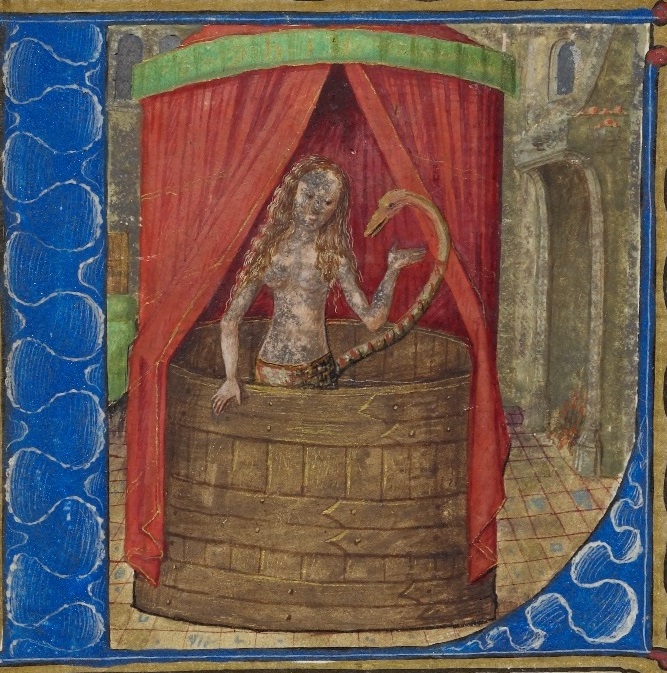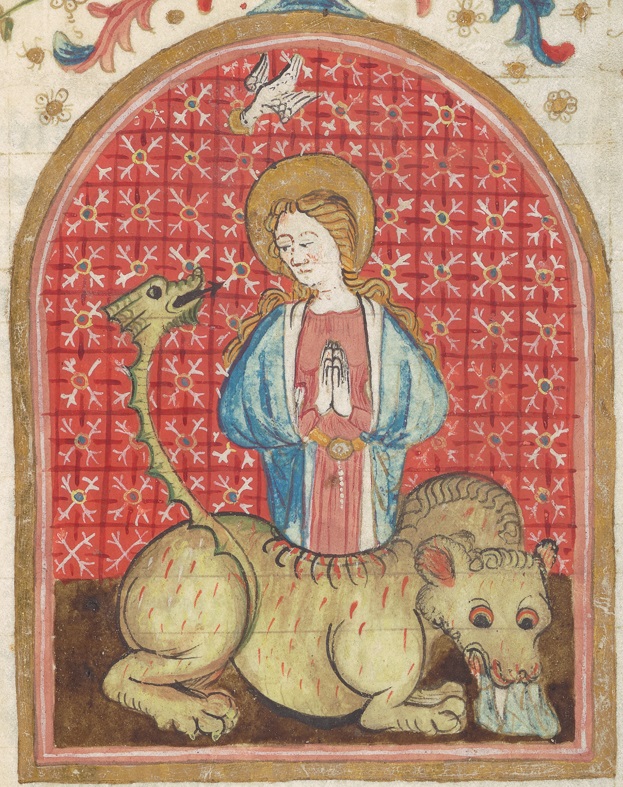
Monsters & manuscripts: the tales of Mélusine & Margaret
This guest post by Dr Miranda Griffin (Fellow in French at Murray Edwards College) explores the imagery in two fifteenth-century manuscripts in Cambridge collections.
This (below left) is a picture of something no mortal should see. It’s the only image in the University Library’s manuscript Ll.2.5, a fifteenth-century paper manuscript which once belonged to John Moore, Bishop of Norwich and Ely (d. 1714) and came to the Library in 1715 when his vast collection was gifted to Cambridge by King George I. The story told in the manuscript is written in fifteenth-century French, and tells of Mélusine, a fairy cursed to turn into a serpent from the waist down on a Saturday for all eternity unless she can marry a man who promises never to ask her what she does on a Saturday. She marries Raymondin, the Count of Poitiers, and swiftly goes about procuring territory and building castles for him, as well as producing ten sons, many of whom become rulers of lands as far afield as Cyprus, Armenia, and Bohemia. In short, she’s the perfect aristocratic wife – apart from the small matter of her absence from court life every Saturday. Inevitably, Raymondin breaks his promise never to see his wife on a Saturday. Alerted by his brother that rumours are circulating that Mélusine is either consorting with fairies or else she is having an affair (which of these alternatives would be least desirable is not clear), Raymondin makes a hole in the door of Mélusine’s chamber and peers through to see his wife happily bathing, human from the waist up, snake from the waist down. And this is the image with which Ll.2.5 opens the story, giving the reader a glimpse of the forbidden sight waiting further on in the tale.
At once a beautiful courtly lady and a terrifying hybrid monster, the figure of Mélusine was fascinating to the readers, authors, and artists of the late Middle Ages: her story was told in several languages, and her appearance imagined in various illustrations. What makes the image in Ll.2.5 unique is that Mélusine’s tail seems to have its own head, which stares Mélusine in the face, in a confrontation between the human and the animal.
This scene resonated for me with another confrontation between human and monster in an illustration kept in another manuscript in Cambridge: Chaytor Additional 10, kept in St Catharine’s College. In this manuscript, also written in French in the fifteenth century, we read the story of St Margaret, a pious shepherdess who was imprisoned by the evil Emperor Olybrius when she refused to renounce her Christianity. In the prison, Margaret is swallowed by a dragon, makes the sign of the cross, and bursts out of the monster’s entrails. In the image on the opening folio of the St Catharine’s manuscript (above right), Margaret emerges unscathed and praying from the dragon – whose tail also has a head, locked in a fierce stare by the saint.
Margaret is the patron saint of people who are pregnant or in labour, and books containing the story of her life would often be present at births. Medieval readers of the tale of Mélusine might have envisaged her praying to St Margaret at the birth of each of her ten sons. In the article I’ve written about these images,[1] in my lectures on medieval French literature, and in my outreach classes for schools,[2] I ask why these images are so powerful, and what they might say about medieval and modern attitudes towards bodies, humanity, monstrosity, and gender. The association between the woman and the serpent, of course, is familiar from the story of the Fall, told in Genesis, the first book of the Bible, and lies behind a lot of medieval and modern misogyny (and, as we know, there’s a lot of both). But as figures of feminine power and virtue, both Margaret and Mélusine seem to engage their serpent in an ambiguous exchange. By looking the monster in the face, are they challenging it? Or are they embracing it?
[1] ‘Mélusine and Margaret: Hybrids and Monstrous Maternity’, in Corps hybrides aux frontières de l’humain au Moyen Âge. Actes du colloque international de Louvain-la-Neuve (19-20 avril 2018), ed. A. Sciancalepore (Louvain-la-Neuve, Publications de l’Institut d’études médiévales: 2020).


